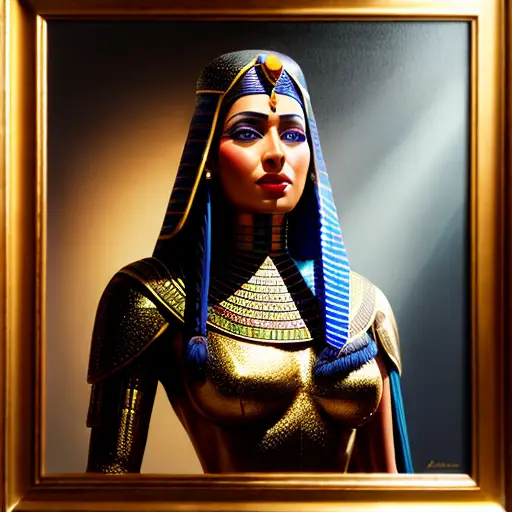In the vast realm of Egyptian art, hieroglyphics hold a special place, like the secret language of ancient pharaohs. And what better way to unravel their enigmatic symbolism than through 'The Painting'? This masterpiece showcases the quintessential characteristic of Egyptian art: its ability to seamlessly blend the realms of the divine and the mortal. As we decipher the intricate hieroglyphics adorning the artwork, we are transported to a world where gods and humans coexist harmoniously. The painting's vibrant colors and meticulous details bring to life the stories of gods and goddesses, immortalizing their presence in the mortal realm. It is through this captivating fusion of symbolism and artistic prowess that 'The Painting' truly encapsulates the essence of Egyptian art, leaving us in awe of its timeless beauty.
An interesting fact about this painting that best illustrates the characteristic of Egyptian art is the use of hieroglyphics. Hieroglyphics were a system of writing used by the ancient Egyptians, and they were often incorporated into their artwork. This painting showcases the intricate and detailed hieroglyphics, which were not only used to convey messages but also to decorate and enhance the overall aesthetic of the artwork. The inclusion of hieroglyphics in this painting exemplifies the Egyptian art characteristic of incorporating writing and symbolism into their visual representations.
In the realm of Egyptian art, 'The Painting' stands as a testament to the enduring legacy and permanence that characterizes this ancient civilization's artistic expression. This masterpiece exemplifies the characteristic of Egyptian art that transcends time, preserving the stories and beliefs of a civilization long gone. The meticulous attention to detail, the vibrant colors, and the use of hieroglyphics all contribute to the artwork's ability to withstand the test of time. 'The Painting' serves as a window into the past, allowing us to connect with the ancient Egyptians and gain a deeper understanding of their culture and beliefs. Its enduring beauty and ability to captivate viewers even today highlight the remarkable permanence that defines Egyptian art, reminding us of the profound impact this civilization has had on the world.

In the realm of Egyptian art, 'The Painting' serves as a stunning example of the characteristic that defines this ancient civilization's artistic expression: the idealized human form. This masterpiece unveils the beauty and perfection that the Egyptians sought to capture in their artwork. The figures depicted in 'The Painting' are meticulously crafted, with elongated limbs, symmetrical features, and flawless proportions. This attention to detail reflects the Egyptians' belief in the divine nature of the human form, as they believed that the gods themselves possessed these idealized physical attributes.
The figures in 'The Painting' exude a sense of serenity and tranquility, further emphasizing the idealized nature of Egyptian art. The calm expressions and graceful poses of the characters convey a sense of eternal beauty and harmony. Through their art, the Egyptians sought to immortalize the human form, capturing its timeless essence and celebrating its inherent divinity.
The use of vibrant colors in 'The Painting' also contributes to the portrayal of the idealized human form. The rich hues and intricate patterns enhance the figures' beauty, creating a sense of radiance and vitality. The Egyptians believed that color played a significant role in conveying the spiritual and symbolic meaning of their art, and 'The Painting' exemplifies this belief through its masterful use of pigments.
'The Painting' not only showcases the idealized human form but also highlights the Egyptians' meticulous attention to detail. Every line, curve, and contour is meticulously rendered, reflecting the precision and craftsmanship that defined Egyptian art. This dedication to perfection is a testament to the Egyptians' reverence for beauty and their desire to create art that would stand the test of time.
In conclusion, 'The Painting' exemplifies the characteristic of the idealized human form in Egyptian art. Through its meticulous craftsmanship, serene expressions, vibrant colors, and attention to detail, this masterpiece unveils the beauty and perfection that the Egyptians sought to capture in their artistic expression. It serves as a timeless reminder of the Egyptians' belief in the divine nature of the human form and their dedication to immortalizing its eternal essence.
Fun fact: This painting best illustrates the characteristic of symbolism in Egyptian art. In ancient Egypt, symbols were used extensively to convey deeper meanings and ideas. This can be seen in the painting through the use of various symbols such as the Ankh (symbol of life), the Eye of Horus (symbol of protection), and the scarab beetle (symbol of rebirth). These symbols were not just decorative elements but held significant cultural and religious significance, showcasing the importance of symbolism in Egyptian art.
In the realm of Egyptian art, 'The Painting' serves as a powerful testament to the characteristic that defines this ancient civilization's artistic expression: the divine connection. This masterpiece reflects the spiritual beliefs of ancient Egypt, showcasing the Egyptians' deep reverence for the gods and their desire to bridge the gap between the mortal and the divine. Through the intricate hieroglyphics and the depiction of gods and goddesses, 'The Painting' brings to life the rich mythology and religious rituals that were central to Egyptian culture. The figures in the artwork are portrayed with a sense of grandeur and majesty, emphasizing their divine nature and their role as intermediaries between the mortal realm and the realm of the gods. 'The Painting' serves as a visual representation of the Egyptians' unwavering belief in the presence and power of the divine, capturing the essence of their spiritual beliefs and immortalizing them for generations to come.